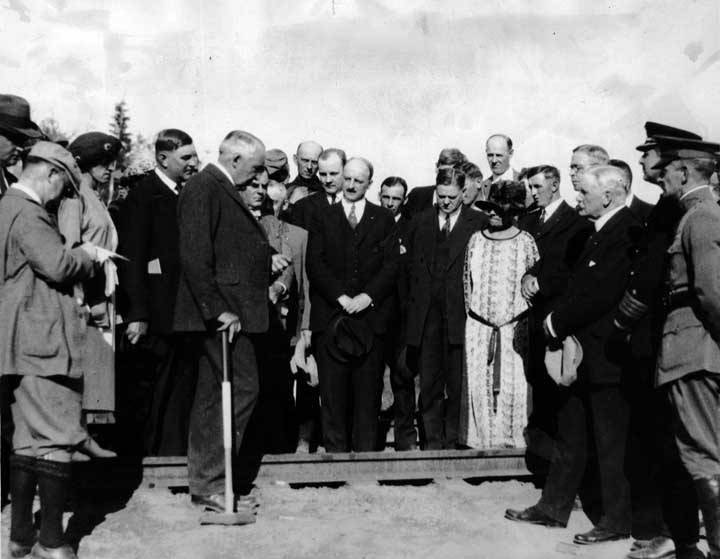Celebrating 100 Years of the Alaska Railroad
Regular train leaving Anchorage with Shriners bound for Fairbanks, August 17, 1922. A.E.C. H-167, B1979.002, Alaska Railroad Photograph Collection, Anchorage Museum.
By Ian Hartman and James Blasingame
On July 15, 2023, the Alaska Railroad will celebrate its 100th birthday.
But the roots of the railroad go back to 1903 when John Ballaine and a small group of Seattle-based investors decided to develop a rail line from the port city of Seward to the Matanuska coal fields. They called it the Alaska Central Railroad. These outside investors did not fully appreciate the challenges of building a railroad in Alaska’s northern environment with its rugged, isolated terrain. The Alaska Central went into bankruptcy within a couple of years. Soon after, another group of investors reorganized the failed Alaska Central Railroad into the Alaska Northern Railway. This effort also failed as the nation spiraled into the economic panic of 1907-08.
A few years later, the US Congress adopted the Enabling Act of 1914, (also known as the Second Organic Act) which authorized the President of the United States full authority to build a railroad from a southern port in Alaska to the Territory’s interior. The passage of the act was in recognition that the federal government had a keen interest in Alaska’s vast natural resources and wanted to ensure that they did not come under private control and ownership. Moreover, the United States wanted to bolster its presence in the North Pacific and Arctic regions. The Alaska Railroad would assist in this mission and serve as a long-term partner to the US military.
W. C. Guerin’s party moving camp across Portage Glacier. W. C. Guerin [six men on glacier, railroad exploration, ca. 1914]. B1979.002/Album 1.89, Alaska Railroad Photograph Collection, Anchorage Museum.
Camp 83, Alaska Engineering Commission, Bird Point, ca. 1915-1917 (Photographer, P. S. Hunt). AEC G608. B1979.002, Alaska Railroad Photograph Collection, Anchorage Museum.
The Enabling Act of 1914 also granted President Woodrow Wilson power to appoint officers, agents, and employees of the would-be railroad. The president could define their duties and set their compensation. Additionally, he could exercise the power of eminent domain and acquire property for use by the railroad and ensure its timely completion. The federal government dedicated significant funding to the railroad’s construction, which set off a migration into the territory with the promise of thousands of well-paying jobs.
To organize the construction effort, President Wilson created the Alaska Engineering Commission (AEC), which was first charged with determining the best route for a rail line from a southern ice-free port to Alaska’s interior. President Wilson and the AEC ultimately chose the 500-mile route from Seward to Fairbanks. Anchorage would serve as the railroad’s headquarters with most workers based out of the rapidly growing hub.
The President does a bit of bridge building, driving the final golden spike at the Tanana Bridge, Alaska Railway, July 15, 1923. ASL-P418-13, Alaska State Library, Juneau.
President Warren Harding driving golden spike, Alaska Railway, July 15, 1923. AMRC-b75-134-186, Cook Inlet Historical Society Collection, Anchorage Museum.
While private investors had initiated the first efforts to build the railroad in 1903, most of the construction occurred between 1914 and 1923, spanning the presidential administrations of Woodrow Wilson and Warren Harding. On July 15, 1923, Warren Harding and his presidential party traveled to Nenana where he drove the ceremonial gold spike into the rail line, marking its completion. After twenty years of fits and starts, a railroad in Alaska opened for business.
The Alaska Railroad remained under federal ownership until January 5, 1985. On that day, after 62 years of federal operation (indeed, some referred to it as the Government Railroad) the sale of the railroad to the State of Alaska for $22 million was complete. The federal legislation, signed into law by Ronald Reagan, was known as the Alaska Transfer Act (45 U.S.C. 1201-1214). Alaska’s senior senator, Ted Stevens, played a key role in crafting the legislation. Once the railroad passed from federal to state ownership, the Alaska State Legislature created the Alaska Railroad Corporation (AS 42.40) as an independent organization.
Although the Alaska Railroad is owned by the State of Alaska, it functions as an independent corporation with a legal existence independent of and separate from the state. Today, the Alaska Railroad continues to operate and remains a fundamental part of the 49th State’s culture and economy. The Anchorage Museum opens an exhibit dedicated to the history of Alaska Railroad later this spring. Other events are scheduled to occur throughout the year as Alaskans commemorate the centennial of this unique Alaskan institution.





